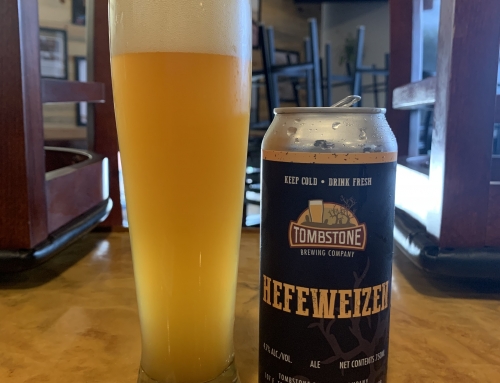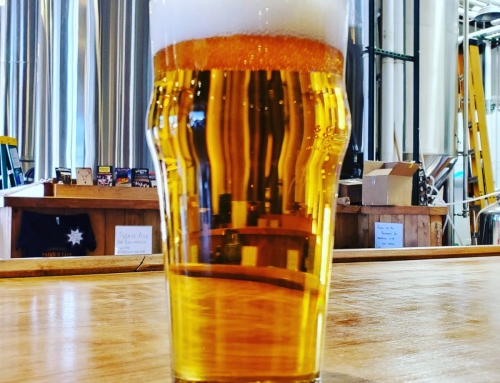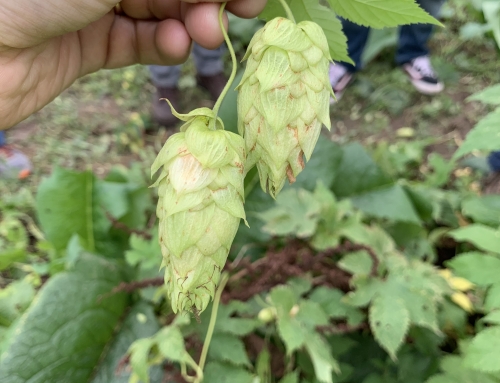It seems like for the last three or four years, during almost every discussion panel, podcast, interview, etc. I’ve participated in, the question “What is the next trend in craft beers?” has been asked. So frequently, the answer I hear is “Lagers.” However, during that same 3-4 year span, lagers haven’t really taken off. With every beer trend that begins, I always wonder what is pushing the trends forward. Frequently, it is brewers trying to find the next big thing rather than customers asking for what the brewers are producing. As I was working through our production schedule for the next 3 months with Matt, I couldn’t help but think about this supposed impending lager boom that’s been on the horizon and why it hasn’t really taken off.
I can’t help but think that as an industry, we craft brewers keep shooting ourselves in the foot when it comes to lagers. Too frequently brewers think of lagers as being cheap beers and as a result, not a lot of effort gets put into them. I look at all the Amber lagers brewed with heaps of caramel malt being labeled as Dunkels and all the Pilsners brewed with American Pils malt, old hops, etc. and I can’t help but think that as an industry, we aren’t introducing high quality examples to the market. I can admit that I was part of that problem when I first started brewing lagers without a really good understanding of how to make them properly. There are notable exceptions of course (Jack’s Abby and Bierstadt Lagerhaus come to mind immediately), and with those exceptions, there comes some real excitement from craft beer drinkers that may have thought of lagers as dull, boring beers. Another reason that the lager boom hasn’t taken place is simply due to the time it takes to produce them which results in it not being worth the time for a lot of brewers to mess with.
As I type this, I can’t help but remember certain beers that influenced my career. I was among the many craft beer geeks that thought I didn’t like lagers even in the first few years of my professional brewing career. The first lager I remember being intrigued by was Sam Adams Noble Pils in its first year of production, sometime around 2009. I remember that first year as being exceptionally hoppy for a Pils and a distinctly complex grassy, floral flavor from the hop combination. Then the next year, I remember being let down by it and that was kind of the end of my excitement towards craft lagers for a while.
Then, in 2014 when I was about to head to Doemens for the World Brewing Academy, I was kind of dreading the beer selection that I would be looking at for the next 6 weeks… No IPA’s, not really any funky options, no stouts, basically no ales other than hefeweizens (which I also thought I hated). Instead, we’d be in Munich where Helles and Dunkels dominate the beer scene. Those six weeks in Europe opened my eyes. Being in a place where lagers have been perfected over the course of around 200 years was a completely different experience. The intense maltiness of the lightest colored Helles brewers could produce was shocking. The assertive ester character from Augustiner’s yeast was exciting to me. The complex malty flavors void of candy like sweetness from overuse of caramel malts and soft mouthfeel of Andech’s Dunkel was eye opening.
As I began experiencing this, I spent a lot of time talking with my German teachers at Doemens about what makes those beers special and I started writing out recipes and keeping a journal of thoughts about how these beers could be introduced to American craft beer drinkers in a way that would get customers excited. Then I had two beers that really changed the way I looked at lagers entirely: Augustiner Pils and a small batch Rauchbier brewed at Weyermann’s pilot brewery.
In both cases, I felt like it was obvious that there was a place for those beers with American craft drinkers. The Augustiner Pils was like an extreme version of my memory of that first year of Sam Adam’s Noble Pils. It was dry, crisp, refreshing, highly carbonated, and filled with noble hop flavor that was floral and grassy, with the intensity of a heavily hopped pale ale. The Rauchbier at Weyermann was delicately smoky with beechwood smoked malt, very full bodied, and it had a beautiful, deep amber color. Pairing that beer with smoked salmon trout (I’m still not entirely sure what that fish actually is, but it was delicious) was one of the best beer and food pairings I’ve ever experienced.
Now, years later, I do believe it is time for some lager styles to boom in the USA, but I don’t think it will necessarily be traditional, sessionable lagers that start the lager craze (although, for a brief span it did look like Vienna Lagers disguised as Mexican Lagers would take off). But rather, I think we can learn a lot from traditional lager brewers as we introduce styles more suited for the craft beer enthusiasts here. Now that we have our lager tanks in Tombstone, we will be producing significantly more of them going forward. We started with a new hop bursted Pilsener and a traditional schwarzbier (Black Lager) which we introduced in cans last week, and now we are moving on to a round of three lagers that is likely to generate a little more curiosity.
The beer I’m perhaps looking forward to the most from this round is a style that even the geekiest of craft beer geeks is unlikely to have heard of before: Kulmbacher. The style originated in Kulmbach, a city in Upper Franconia, Bavaria, and there is a lot of room for confusion here. Today, there is a brewery that shares the name of the style and further complicating things, the Kulmbacher brewery is actually 4 breweries from Kulmbach that merged together in the 1980’s, and they don’t brew the traditional Kulmbacher style. The city of Kulmbach has a brewing history that dates back almost 670 years to 1349. Located in Upper Franconia, the city is sometimes referred to as “The Secret Capital of Beer” and it has the largest amount of breweries per capita of any city in Germany.
As with most German cities, Kulmbach had its own style of beer that it was known for in the late 1800’s and early 1900’s. The Kulmbacher style was known for being dark with a rich malt flavor and heavily hopped. Several things lead to the phasing out of the interesting style, but two things are most notable. First, around 1900, breweries in Kulmbach received warnings that they were breaking the Reinheitsgebot due to the use of caramel coloring to make the beer appear darker. Also around that time, German palates began to shift in favor of beers with less bitterness. The Kulmbachers being produced at that time were strong beers at 6.0-8.0% ABV and it was not uncommon for the bitterness to be up around 80 IBU’s. I recall discussing this style with one of our teachers at Doemens when we were learning about “extinct” German styles.
Recently, an article was written by a beer historian, Ron Pattinson, and published on BeerAdvocate.com. When I saw the article, it reminded me of that talk and how at the time I wanted to attempt brewing one. I went back through my brewing notes and found the recipe that I had written down after that discussion. My take on the style is something that I think will suit modern palates well while still maintaining historical accuracy. The malts we used come from Weyermann which opened its doors during the Kulmbacher heyday in 1879. The basemalt used at the time would have been similar to what we know today simply as Munich Malt. However, when recreating a historical style, there are many factors in regard to ingredient selection that need to be thought about.
About every 10 years now, advances in barley varieties result in old varieties getting phased out in favor of varieties with better agronomics. Unfortunately, flavor can frequently suffer in newer varieties as the focus is more on the growing habits than flavor. On occasion, maltsters will realize that a variety is getting phased out and will intervene in order to preserve varieties that they think of as being worthy of continued use. Weyermann realized the special flavor qualities of Barke barley and convinced a few growers in Bavaria to continue planting it. It is now listed as an heirloom barley variety and is notable for its richness and depth of flavor. The Barke Munich malt has an incredible classic Munich toasty flavor and is very similar in flavor to what would have been used 150 years ago (although, malting technology has gotten so much better now that the quality control and consistency is going to be significantly improved).
One of the intriguing things about the Kulmbacher style also was that the breweries there used their own unique type of decoction mash schedule for these beers. Instead of a 3 step mash, only one decoction was used and it was not so much for flavor development or even for the necessity of modifying the malt further. The brewers there would decoct the mash, take the decoction and begin boiling it as is normal, but then they would leave a small amount of the liquid in the boil kettle and do their first hop addition. Sometimes referred to as “hopfenrosten” or “hop roasting.” The utilization of the hop acids would have been very poor, but the goal of that technique is not that different from utilizing a first wort hop addition which is how we went about recreating that particular part of the style without a decoction mash.
Perhaps the most interesting part of this style from a historical perspective is that when the brewers were warned about the use of caramel coloring, the beers had to have changed drastically. To still get the same dark color brewers had to switch to roasted malts which would have increased the roastiness and astringency. Not so coincidentally, in 1902 Weyermann released a special additive, Sinimar, which is completely Reinheitsgebot compliant. It is made from their dehusked roasted malt, hops, and yeast, and concentrated via evaporation, sterile filtered, and packaged. Due to their unique process, it has a pleasant roasted chocolate flavor with even less astringency than you would find in dehusked roasted malts. The use of Sinimar in our version creates a very dark brown, almost black appearance.
Overall, it would be appropriate to describe our version of the beer as a sort of Brown IPL (or India Brown Lager if you hate the oxymoron) with 100% traditional German ingredients. We used a comparable hopping rate to the norm of original examples, but we used a hopping schedule more similar to our lowly bittered, highly aromatic Pils. Other than the small First Wort Hop, all the hot side hops were added in the whirlpool and the beer will be dry hopped. 100% of the ingredients we used were grown and processed in Bavaria with the hops being the traditional Hallertauer Mittelfruh. The Barke Munich was malted just 37 miles away from Kulmbach and our yeast came from one of Bavaria’s oldest and most well known lager breweries. With our RO water, we were able to recreate exactly the moderately hard water profile that would have been used in the early 1900’s. Reintroducing styles like this is one of my favorite things to do as a brewer.
The second beer we brewed this week was a Double India Pale Lager. This beer is using fruity, American grown hops just like we would use in our NEIPA’s: Idaho 7, Citra, and Mosaic. Sticking with my thought of keeping some traditional lager elements, I used another very traditional type of malt. For this beer, the majority of the malt used was Floor Malted Bohemian Pilsner Malt grown and malted in the Czech Republic. The terroir for this growing region results in a very soft mouthfeel from the barley and the floor malting is a traditional malting method that results in more depth of flavor and a richness that has not yet been created with modern malting techniques. This beer will feature many elements that you would expect from a Tombstone Double IPA with an insane hopping rate, but will have a crisp, well lagered mouthfeel.
The final beer we brewed this week was a Doppelbock which also features a large amount of Barke Munich Malt, Floor Malted Pils Malt, and Sinimar. We brewed 30 BBL of the doppelbock and half of it will be lagered in a mix of bourbon and other spirit barrels while the other half is released in cans.





Amazing blog. I enjoyed reading this.